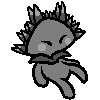Flytrap Type
|
“Flytrap types benefit from being able to heal without consuming food type TCPs, but at the cost of needing to eat living things…or just normal food.” | ID: 0493 |
| Type: Flytrap | |
| Category: Nature | |
| Height: 6.5 inches | |
| Max Health: GREAT (6) | |
| Ability: SENSITIVE SNAPPER At the sacrifice of health, flytrap types can create and control flytrap plants of various sizes. These flytraps can snap shut either at the typings or when something triggers the sensitive hairs on the inner surface of their jaw-like leaves. Anything contained within the leaves when it snaps shut will be coated in organic acids in an attempt to digest it. Captured items that are digested restore a small amount of health to the parent flytrap type. |
|
| Physical Appearance: Flytrap types have a standard-shaped body and a wide flat head. Their head can open laterally, opening into a wide flytrap “mouth” or trap. They have teeth-like structures around their head which weave together when closing. They have two arms and two legs. They have two leaves projecting from their collar. Flytrap types have markings on their teeth-like structures and on their face, those taking the form of cheek spots. They have curved eyespots and their earnubs are among their teeth-like structures. | |
| Voice: Snapping and snipping. | |
| External: Plant material. | |
| Internal: Xylem and phloem. | |
| Special Attributes: None. | |
| Other Notes: Flytrap types enjoy moist, warm environments, and often need semi-aquatic accommodations with nutrient-enriched bog water to fully thrive, however, they can get by with semi-frequent hydration, like many semi- and fully-aquatic TCPs. Flytraps enjoy sedentary activities, especially while snacking, and often post up in locations where small insects are common, to the point where some municipalities have taken to compensate them for time spent both enjoying public locations, creating flytraps, and trapping insects themselves. Flytrap types are very sociable and tend to congregate with each other and others, especially individuals who have typings that tend to attract insects. Beyond their utility as living pest control, many flytraps find employment as gardeners, especially in the maintenance of semi-aquatic gardens, including the care and maintenance of ornamental fish, such as Mire Carp. Flytrap types love live food, especially insects, and eat a wide range of foods besides that. |
Official Documentation
Documented Cases
Unconfirmed Sightings
Designed by Ringor Mortis. ©2019



